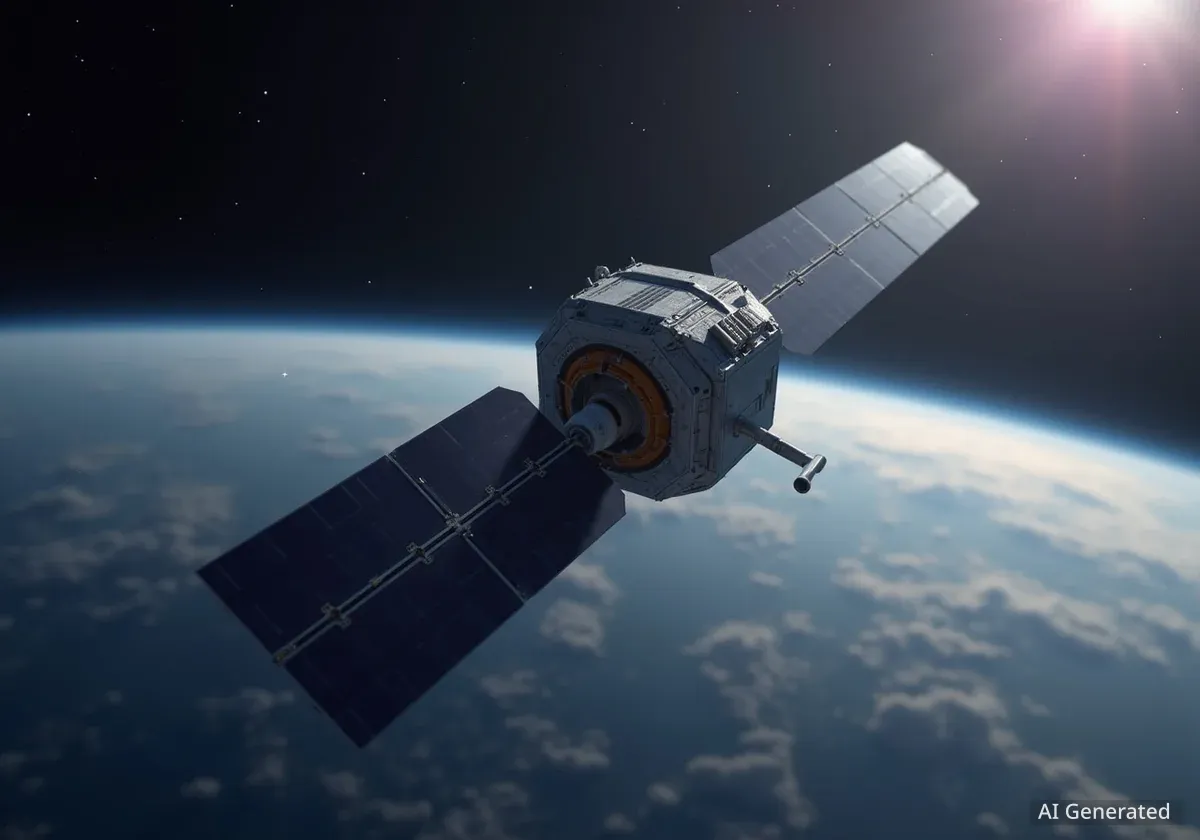The U.S. Space Force is fundamentally changing its approach to space domain awareness, mandating that its next generation of surveillance satellites be refuelable in orbit. This new requirement is part of a broader shift toward using commercially developed spacecraft for the upcoming RG-XX program, which will replace the current fleet of specialized military satellites.
This strategic pivot aims to increase the operational flexibility and lifespan of critical assets in an increasingly contested space environment. The move also opens the door for multiple commercial vendors to build and potentially service the new fleet, marking a significant departure from traditional defense acquisition models.
Key Takeaways
- The U.S. Space Force's next surveillance satellite program, RG-XX, will require all spacecraft to be refuelable in orbit.
- The new satellites will be commercially derived, unclassified, and available for foreign military sales, replacing the bespoke GSSAP system.
- Maj. Gen. Stephen Purdy, Jr. stated the refueling requirement was a personal mandate to enhance orbital mobility.
- Multiple commercial companies, including Northrop Grumman, Astroscale, Orbit Fab, and Firefly Aerospace, are developing related on-orbit servicing and refueling technologies.
A New Era for Orbital Operations
The Space Force is preparing to replace its current Geosynchronous Space Situational Awareness Program (GSSAP) satellites. The new initiative, known as RG-XX, represents a major evolution in military space strategy. Instead of custom-built, classified hardware, the service will acquire satellites from commercial space companies.
A core feature of this new program is the mandatory inclusion of on-orbit refueling capabilities. This requirement is designed to give the satellites extended lifespans and greater maneuverability, allowing them to respond to threats and monitor objects of interest without the constraints of a finite internal fuel supply.
"It absolutely has a refueling requirement. I mandated that and was very militant about that."
The statement was made by Maj. Gen. Stephen Purdy, Jr., acting Air Force assistant secretary for acquisition and integration, at the Air and Space Forces Association’s Air, Space and Cyber Conference. He emphasized that the RG-XX program is a way for the service to formally integrate refueling into an operational system.
Transitioning from GSSAP to RG-XX
The current GSSAP satellites, built by Northrop Grumman, have served as the military's orbital "neighborhood watch." Operating in near-geosynchronous Earth orbit (GEO), these spacecraft can perform rendezvous and proximity operations (RPO) to inspect other space objects.
The GSSAP Legacy
The Geosynchronous Space Situational Awareness Program (GSSAP) was once a classified program. The first two satellites were launched in 2014. A total of six have been launched to date, but their operational life is limited by their onboard fuel. In 2023, the Space Force retired the second satellite, GSSAP-2. Two more, GSSAP-7 and -8, are scheduled to launch on a United Launch Alliance Vulcan Centaur rocket.
However, the GSSAP fleet is aging and limited by its fuel capacity. The move to the RG-XX program addresses these limitations directly. By using commercially developed platforms, the Space Force can leverage private sector innovation and reduce development costs. Furthermore, the new satellites will be unclassified, which allows for sales to allied nations.
Challenges of a Multi-Vendor Approach
While the commercial approach offers benefits, it also presents logistical challenges. A key issue is the potential for different fuel types across satellites built by various vendors. According to Maj. Gen. Purdy, this could complicate the refueling process.
The Space Force is still finalizing its acquisition strategy. Options include requiring vendors to supply their own refueling vehicles or awarding a separate contract to a dedicated refueling service provider. This decision will be critical in establishing a standardized and efficient on-orbit servicing ecosystem.
The Commercial Sector's Role in On-Orbit Servicing
Several aerospace and defense companies are already developing the technologies needed to make in-space refueling a reality. These efforts are supported by both private investment and government contracts, positioning the industry to meet the Space Force's new requirements.
On-Orbit Servicing Milestones
In April 2025, Northrop Grumman's subsidiary, SpaceLogistics, successfully undocked its Mission Extension Vehicle (MEV) from an Intelsat satellite after providing five years of life-extension services. This demonstrated the viability of commercial servicing in geosynchronous orbit.
The industry is rapidly advancing toward more complex servicing missions, including refueling. A number of key demonstrations are planned for the coming years.
- Northrop Grumman: The company is developing next-generation servicers called Mission Extension Pods, set to launch in 2026. It is also working on a refueling payload named Elixir for a demonstration scheduled for no earlier than 2028.
- Astroscale U.S.: In 2026, Astroscale plans to conduct two on-orbit refueling demonstrations for the Space Force using its Refueler APS-R spacecraft to service a U.S. military satellite in GEO.
- Orbit Fab: The Defense Innovation Unit (DIU) is funding Orbit Fab to build an in-space fuel depot. This depot will be part of the Tetra-5 demonstration in 2026, where an Astroscale spacecraft will dock with it.
- Firefly Aerospace: Firefly has a DIU contract to demonstrate RPO capabilities with its Elytra space vehicle in 2027. The company's CEO, Jason Kim, stated this mission positions Firefly to compete for the RG-XX program.
Robert Hauge, President of SpaceLogistics, confirmed the industry's alignment with military goals. "Where we want to get to is the same place the Space Force is asking us, which is the ability to refuel in space," he said at the conference.
Implications for National Security and the Space Economy
The introduction of refuelable, commercially sourced satellites marks a pivotal moment for U.S. space policy. For U.S. Space Command, enhanced mobility is a top priority. The ability to refuel satellites provides unprecedented tactical advantages, allowing for sustained surveillance and rapid repositioning of assets.
This initiative is also expected to accelerate the growth of the commercial on-orbit servicing market. By creating a clear government demand for refueling services, the RG-XX program provides a strong incentive for private companies to invest further in these capabilities. This could lead to a robust in-space economy where satellites are routinely serviced, repaired, and refueled, extending their value and utility far beyond their original design life.
The RG-XX program is more than just a satellite replacement; it is a foundational step toward a more dynamic, resilient, and commercially integrated space architecture for the United States and its allies.





